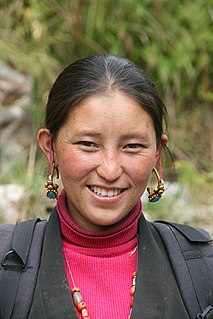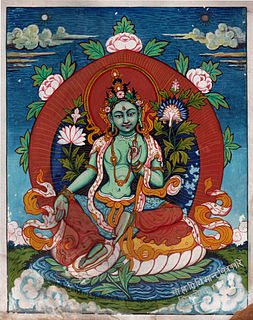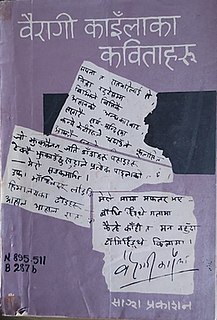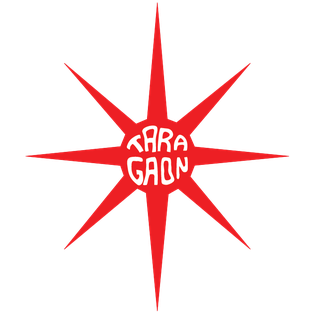Related Research Articles

Kathmandu, officially the Kathmandu Metropolitan City, is the capital and the most populous city of Nepal with 845,767 inhabitants living in 105,649 households in 2021 and 2.9 million people in its urban agglomeration. It is located in the Kathmandu Valley, a large valley in the high plateaus in central Nepal, at an altitude of 1,400 metres.

Music of Nepal refers to the various musical genres played and listened to in Nepal. With more than fifty ethnic groups in Nepal, the country's music is highly diverse. Genres like Tamang Selo, Chyabrung, Dohori, Adhunik Geet, Bhajan, Filmi music, Ghazal, Classical music, songs and Ratna music are widely played and popular, but many other less common genres are yet to be cataloged. Western musical genres like Rock, Metal, Hip-Hop, Rap, R&B also regularly feature on the Nepalese music charts. Most of the country's musical bands are based in the Kathmandu valley. Musical genres from Tibet and India have greatly influenced Nepalese music.

Bhaktapur, known locally as Khwopa, is a city in the east corner of the Kathmandu Valley in Nepal located about 13 kilometres (8.1 mi) from the capital city, Kathmandu. In terms of area, Bhaktapur is the smallest city of Nepal. Geographically, it is located on a small hill on the eastern part of the Kathmandu Valley and is flanked by the Hanumanté and Khasyāngkhusung rivers in the north south direction. Most of the inhabitants in Bhaktapur are of Newar ethnicity and Nepal Bhasa is spoken predominantly.

The Tamang are an tibeto-burmese language speaking indigenous ethnic tribal community native to Nepal. In Nepal Tamang/moormi people constitute 5.6% of the Nepalese population at over 1.3 million in 2001, increasing to 1,539,830 as of the 2011 census. Tamang people are also found in significant numbers in the Indian state of Sikkim and districts of Darjeeling and Kalimpong in West Bengal state of India and various districts in the southern foothills of the Kingdom of Bhutan. Such districts include the Tsirang District, the Dagana District, the Samtse District, the Chukha District, the Sarpang District and the Samdrup Jongkhar District. Tamang language is the fifth most spoken language in Nepal.
Mahananda Sapkota (1896–1977) was a Nepalese social worker, etymologist, linguist, and poet. He received several national awards for his contributions to poetry. His social work focused on education and social awareness particularly in eastern Nepal. A statue of him stands in Inaruwa of Sunsari District.

Chitrakar is a caste within the Newar community of the Kathmandu Valley in Nepal. The Newar caste system is divided according to profession. Accordingly, Chitrakars were painters and mask makers. In Nepal Bhasa, this caste is called "Pun" (पुं) or "Puna". The literal translation of the word Chitrakar from Sanskrit is image maker where "Chitr" in Sanskrit means an image, and "akar" the maker.

Lain Singh Bangdel / Lain Bangdel (Rai), was Nepal's foremost artist, novelist, and art historian. In addition to being a leading authority on Nepalese art, Bangdel is best known as the "father of modern art" and was responsible for introducing the modern trends of Western art into Nepal with his pioneering one-man exhibition in Kathmandu in 1962.

Manjushree Thapa, born in Kathmandu, is a Canadian essayist, fiction writer, translator and editor of Nepali descent. She is one of the first English writer of Nepali descent to be published internationally. Forget Kathmandu and The Tutor of History are some of her most well known works.

Sushma Joshi is a Nepali writer, filmmaker based in Kathmandu, Nepal. Her fiction and non-fiction deal with Nepal's civil conflict, as well as stories of globalization, migration and diaspora.

Dayahang Rai is a Nepali actor, director, and playwright. Dayahang is known for his uniqueness in Nepali cinema. He is one of the most popular and acclaimed actors of Nepal. He has starred in over 40 films and is one of the leading contemporary actors of Nepal. He has received various accolades throughout his acting career. Dayahang is a veteran theatrical actor who made the jump to Nepali cinemas.
Bibeksheel Nepali Dal is a political party in Nepal. The name "Bibeksheel" translates to "common sense wisdom".
The Nepal humanitarian crisis (2015-2017) developed owing to a lack of action following the April 2015 Nepal earthquake and its aftershocks. It was compounded by political factors as a result of the 2015 Nepal blockade. Victims of the earthquakes were still living in flimsy, temporary shelters more than a year after the initial devastation. The governmental National Reconstruction Authority had not devised relocation plans for these people as recently as July 2016. In Sindhupalchok District, the region that had suffered the worst devastation, the humanitarian situation was a little better towards the end of 2016 than it had been in 2015.

Sunil Pokharel is a Nepali theatre artist and director. He is considered one of the pioneers of modern Nepali theatre. He is a graduate of National School of Drama, India (1987). He has directed more than four dozens of varied Nepali, Indian and European plays.

Nepal Literature Festival is an annual international literary festival which takes place in Pokhara, Nepal. It was founded in 2011 by Bookworm Foundation, a not-for-profit organization. IME Group is the current title sponsor of the festival.
Krishna Bahadur Rai is a Nepali politician and a member of the House of Representatives of the federal parliament of Nepal. He was elected from Kathmandu-3 constituency, representing CPN UML of the left alliance, under the first-past-the-post electoral system. This is the first time he has been elected to parliament. He defeated his nearest rival Ambika Basnet of Nepali Congress by acquiring 19,169 votes to Basnet's 14,884.
Photo Kathmandu is a biennial international photography festival held in Patan, Nepal, and organised by photo.circle, a Kathmandu based cultural organisation, and Shikshya Foundation Nepal.
Professor Jaya Raj Acharya was ambassador of Nepal to the United Nations from 1991 to 1994, and is a well-known scholar of Nepal. He lectures at Tribhuvan University, has written many books, and is a prominent foreign policy expert especially in Nepal's relations with India and China. He's raised awareness of Nepal's education, state of Nepali politics etc. in international forums. He's done numerous TV appearances in the Nepali Media.

Bairagi Kailaka Kabitharu is a 1974 Nepali poetry collection by Bairagi Kainla. It was published in 1974 by Sajha Prakashan. It is the first book of the author. The poems in this collection were later reprinted in a book titled Bairagi Kainla ka Sankalit Kavita with his other poems by Phoenix Books. Kainla is known as progenitor of the Tesro Aayam movement in Nepali literature alongside Indra Bahadur Rai and Ishwor Ballav. He received the Sajha Puraskar for this book.

The Taragaon Museum is a private art museum and library located in Kathmandu. It is located in the northern part of the city near the Bouddhanath stupa. It is situated on the ground of the Taragaon Regency hotel, which owns the museum. The museum is supported by The Saraf Foundation. The museum features a permanent collection in three of its building alongside Bodhisattva Gallery that displays Newa art, Pathivara Gallery that displays thangka paintings, and a contemporary art gallery.
References
- ↑ "Nepal Speakers Bureau |". test.nepalspeakers.com. Retrieved 2021-12-15.
- ↑ "Meet the Man Behind the "White Butterflies" Flying Across the Globe". HuffPost. 2015-05-31. Retrieved 2021-12-15.
- ↑ "'White Butterflies in Macau' rescheduled" . Retrieved 2022-01-08.
- ↑ Diwakar (2016-04-06). "Butterfly effect". The Himalayan Times. Retrieved 2022-01-08.
- ↑ Lama, Yangzum (2019-10-03). "Vrikshya: Creating Spaces for Nature, Community and Art | Blinc Ventures" . Retrieved 2021-12-15.
- 1 2 3 4 "Conversations.org: A Conversation with Milan Rai, by Pavi Mehta, Richard Whittaker". www.conversations.org. Retrieved 2021-12-15.
- ↑ Awakin.org. "Milan Rai | Awakin Call". www.awakin.org. Retrieved 2021-12-15.
- ↑ Shrestha, Sahina. "The butterfly effect | Nepali Times Buzz | Nepali Times". archive.nepalitimes.com. Retrieved 2021-12-15.
- ↑ "How Far Have Butterflies Flown?". mydreamsmagazine.com. Retrieved 2021-12-15.
- ↑ "Visiting Artist Profile: Milan Rai • The Lakshmi Mittal and Family South Asia Institute". The Lakshmi Mittal and Family South Asia Institute. 2018-07-13. Retrieved 2021-12-15.
- ↑ "Green Spaces: Frustrated nature lovers' effort to revive greenery in Kathmandu - OnlineKhabar English News" . Retrieved 2021-12-15.
- ↑ Furber, Sophia (2015-05-13). "Nepal earthquake victims given hope as artist's butterfly campaign raises vital funds for shelter and sanitation". mirror. Retrieved 2022-01-08.
- ↑ Ekin, Annette. "Nepal quake disaster". www.aljazeera.com. Retrieved 2022-01-08.
- ↑ Ekin, Annette. "Nepal quake disaster". www.aljazeera.com. Retrieved 2021-12-15.